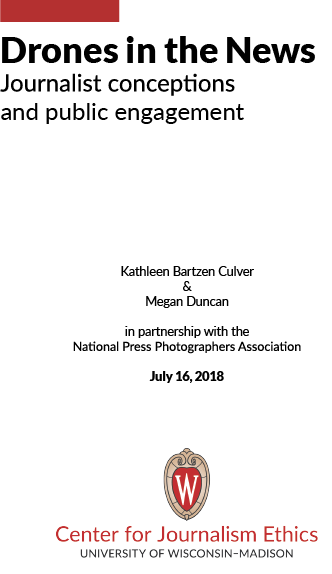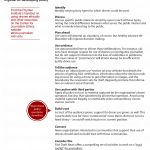Drones in the news: Journalist conceptions and public engagement
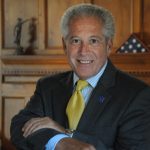
Foreword
In an ongoing effort to assess and support the use of drones for newsgathering and reporting, the National Press Photographers Association (NPPA) is once again honored to partner with the Center for Journalism Ethics (CJE) in presenting its latest survey results regarding Drones in the News: Journalist Conceptions and Public Engagement. While news organizations and individual journalists are safely integrating drones into their daily operations, as well as the national airspace, it is crucial to remember that this evolving technology still faces many regulatory and legislative hurdles, not to mention privacy issues and ethical concerns.
As the legal and ethical aspects of drone journalism develop, those using this technology face new questions, challenges and opportunities presented by the Federal Aviation Administration and other federal agencies, legislators and the judicial system, with the greatest scrutiny coming from the court of public opinion.
To chart a better course in addressing these wide-ranging topics, newsrooms need to develop proper and workable policies and guidelines. One of the tools to successfully accomplish that task is through the findings and suggestions found in the following survey. It is our hope that the data and analysis will help educate the public, allay unfounded fears, improve communication with citizens and other stakeholders and build support for drone use in newsgathering and reporting.

Introduction
In May 2018, St. Louis Public Radio data and visual journalist Brent Jones joined a host to discuss his station’s use of a new and expanding technology being used in journalism: drones. Jones discussed the reasons journalists employ drones as tools, including expanding their perspectives and getting access to spaces they otherwise could not reach, and the ethical considerations that accompany drone use, especially protecting personal privacy.
Jones’ interview is a good example of the kinds of tactics the Center for Journalism Ethics recommended in its 2017 report on public opinion of drone use in news. Finding that respondents were moderately supportive of drone journalism, the Center suggested news organizations:
- develop specific policy related to drone use, including articulating how such use can serve public interests.
- focus on building trust overall, which then extends to support for drone use.
- foster openness and participation, including covering drone use and inviting public comment.
Yet new data collected by the Center for Journalism Ethics (CJE) and the National Press Photographers Association (NPPA) shows other journalists and organizations may be less inclined to engage in these efforts than Jones and St. Louis Public Radio were. Through a national survey of 92 journalists using or considering using drones, CJE and NPPA elicited opinions on drone use in varying story categories, ethics considerations, openness to public participation and development of policy. This report covers the central findings revealed by the survey and offers suggestions for building on the findings from the public survey to improve communication with citizens and build support for drone use.

Purpose
At a time of increasing scrutiny of news media accuracy and its contributions to democracy, journalists and news organizations are wise to consider how the public evaluates their practices and how they can positively affect those perceptions. Drone use is one important arena in which to engage in these questions. Journalists primarily use drones to capture video and still images, but they also can be used to live-stream video, gather data and map terrain.
The Federal Aviation Administration regulates use of drones for commercial purposes and has classified journalism as a commercial use. The FAA’s Small Unmanned Aircraft Rule, known as Part 107, established an operator’s certificate for commercial users, including journalists. The certificate requires users to pass a test covering basic knowledge of airspace and aeronautics. Part 107 also established specific restrictions, barring:
- commercial use of UAVs weighing more than 55 pounds
- UAV flight above 400 feet in most cases
- night flight
- flights over people not involved in the operation of the UAV
- reckless or careless operation
- flight in restricted airspace without permission (airspace restrictions vary based on size and location of an airport)
- flight beyond the operator’s visual line of sight
News organizations and trade groups like NPPA have worked to operate within the bounds of the FAA guidelines, including efforts in 2017 and 2018 to train hundreds of journalists across the country to pass FAA drone certification. These trainings, led by the Poynter Institute, focused on regulatory matters necessary for certification while also offering rigorous instruction in ethics.
Building from those sessions, this study focused on journalists who are using or considering using drones in news. Specifically, it sought to assess:
- comfort with drone use in a variety of story categories, such as investigative reporting or live events.
- opinion of the implications of journalists’ and citizens’ use of drones.
- benefits and barriers to drone use in newsgathering and reporting.
- comfort with using footage obtained by journalists in varying situations.
- comfort with using footage supplied by non-journalists in varying situations.

Methodology
The Center for Journalism Ethics, in partnership with the National Press Photographers Association, conducted a survey of 92 adult journalists living in the United States using an online questionnaire. Participants were recruited through online social media posts, emails and newsletters. It was open to any journalist. The survey was conducted between Dec. 15, 2017, and Jan. 24, 2018. Participants were solicited through online posts and emails to NPPA members. Participants were asked to fill out a 20-minute survey on their computers, tablets or mobile devices. Participants were eligible for one of 10 $50 gift cards.
The participant pool was:
- Aged 45-54 on average
- 76 percent male
- 5 percent Hispanic; 3 percent Asian; 2 percent African-American; 86 percent white
- $50,000-$59,000 average salary
- 81 percent had at least a 4-year degree
We asked the participants about their current experience with drones, how they would tell stories and interact with the public when using drones, and their opinions on ethical issues concerning drones. The respondents answered our questions on scales ranging from 1 to 5, where 1 indicated low levels of support or agreement and 5 indicated the highest level of support or agreement.
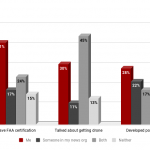
Drone ownership and policy
A majority of participants had direct contact with a drone used in journalism. About 82 percent said either they personally (32 percent) or someone else in the newsroom had a drone. Similarly, 85 percent said they personally (42 percent) or someone else in the newsroom had FAA authorization to fly a drone commercially.
Yet a third of respondents said neither they nor their newsroom had developed a policy regarding drone use, and 37 percent said they had taken no steps to give the public information about drone use or newsroom policies.
Use scroll bar to see the entire graph.
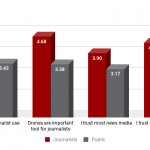
Support and trust
Participants in general supported the use of drones by civilians and journalists. The support reported for the use of drones by journalists and civilians was significantly stronger among the sample of journalists than an earlier sample of citizens (detailed in a 2017 Center for Journalism Ethics report). Additionally, while the public sample reported about equal support for drone use by journalists and civilians, the sample of journalists favored journalists by more than 0.5 points on a 5-point scale.
Use scroll bar to see the entire graph.
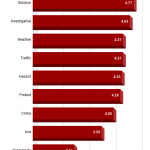
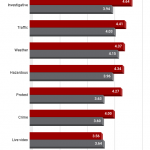
Support for drone use in newsgathering and reporting
We see the highest level of support for using drones in news stories about the outdoors. This includes stories about the environment, outdoor activities, weather and traffic. Investigative news stories also received a high level of support. News stories about celebrities and personal lives of politicians got the lowest levels of support.
The story categories in the survey were:
- Get video of breaking news involving a crime, such as a mass shooting
- Cover a story on the outdoors, such as best places to rock climb
- Document impropriety by well-known figures, such as a politician having an extramarital affair
- Cover celebrity events, such as a wedding
- Get video from breaking news involving a hazardous incident, such as a fire
- Do investigative reporting, such as a long-term look traffic safety in an area
- Show raw footage of events live as they happen, such as high-speed police chases
- Monitor traffic congestion, such as a live feed during rush hour
- Cover severe weather events, such as a hurricane
- Monitor possible environmental damage, such as rising sea levels
- Report on civilian protests, such as the Occupy movement
The journalists overall showed more support for the use of drones than members of the public. In almost all categories of stories, journalists had higher levels of comfort than the public when asked about journalists using a drone to report on that category of story. This difference was particularly pronounced in the categories of outdoor and environmental stories, where the average journalist was respectively 0.9 and 0.8 points more supportive than the average audience member on a 5-point scale. However, this relationship was reversed for the categories of investigating the personal lives of politicians and reporting on celebrity news. In these categories, audiences were more likely to support the use of drones than journalists.

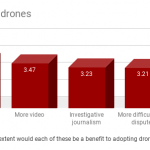
Barriers and benefits
Overall, journalists reported the barriers to adding drones to the newsroom were of low concern. However, safety and liability were the largest barriers.
Use scroll bar to see the entire graph.
Participants were more enthusiastic about the benefits of drones in journalism. They said that the opportunity to have more visuals and video with stories and the ability to do more types of news stories were the largest draws to adopting drone journalism.
Use scroll bar to see the entire graph.
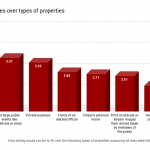
Flying drones
Participants said they were most comfortable flying drones over government-owned buildings and land, as well as large public events. They were less comfortable flying over privately owned businesses and least likely to fly over private homes and homes of elected officials. They were unlikely to follow a person over the course of an hour or to fly over the home of a celebrity.
Use scroll bar to see the entire graph.
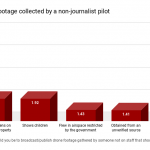
Non-journalist footage
Hobbyists are subject to fewer regulations and may not be held to the same safety rules and ethical guidelines used by journalists, especially those who have been formally trained and earned FAA certification. If footage captured by a hobby pilot is newsworthy, this could create an ethical dilemma for journalists as they balance the public’s need to know with the seeming endorsement of unsafe flying practices.
Participants said they were very unlikely to show footage if it featured a drone flying in an unsafe manner or an area restricted by the government. They were slightly more likely, though still unlikely, to show footage by non-journalists if it showed private citizens on private land.
Use scroll bar to see the entire graph.

Support needs
Participants reported that they could use the support of professional organizations to provide guidance for adopting drones in the newsroom. Particularly they reported that they could use policy examples and ethical guidelines from organizations like CJE and NPPA. They were less interested in in-person meetings and trainings than online support.
Use scroll bar to see the entire graph.
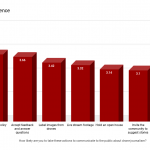
Communication with the public
Participants reported that they could use the support of professional organizations to provide guidance for adopting drones in the newsroom. Particularly they reported that they could use policy examples and ethical guidelines from organizations like CJE and NPPA. They were less interested in in-person meetings and trainings than online support.
Use scroll bar to see the entire graph.

Based on the insights gleaned from this survey of journalists and the previous survey of the public, we recommend news organizations and individual journalists engage in active practices related to drone use for news.
Develop policy
- Consider story types that arise within the organization and think in advance about the appropriateness of drone use in those situations.
- Address not just what would make for interesting video or data, but more importantly about what serves the public interest.
- Post policy publicly, so citizens can access it if interested and other news organizations can use it as a model.
- St. Louis Public Radio offers its drone operations manual, including ethics guidelines, for anyone interested in the resource.
- Other useful resources include the 2017 Center for Journalism Ethics report, safety-focused guidelines led by the Poynter Institute, manuals and other guides from the University of Nebraska Drone Journalism Lab.
- Aim to be diverse and inclusive when deciding who to train to use drones, as the overwhelmingly male sample responding to this survey highlights a lack of gender diversity in the ranks of drone journalists.

Communicate clearly
- Label all images and footage that have been captured through drone flight.
- When posted online, link such labels to drone policy.
- Work proactively with law enforcement and other governmental organizations to advocate for responsible drone use in coverage and avoid draconian restrictions.
- Cover journalists’ and hobbyists’ drone use, emphasizing responsible practices and de-emphasizing sensational scare tactics.

Open avenues for participation
- Establish a means for audience members to suggest story ideas that might benefit from drone coverage.
- Interact with citizens via social media specifically on the topic of drones. This could be as simple as a Facebook Live session to take drone questions. The Trusting News Project has examples of a variety of ways to engage authentically.
- When possible and safe, answer questions about drone use when at a scene.

For more information
- 2017 Center for Journalism Ethics report on public opinion of drones in journalism
- National Press Photographers Association drone resources
- Drone Journalism Lab, University of Nebraska, Drone Operations Manual
- First Draft News, trust toolkit
- FAA Part 107 summary, and full rulemaking
- Poynter Institute, drone ethics guidelines
- Professional society of drone journalists

